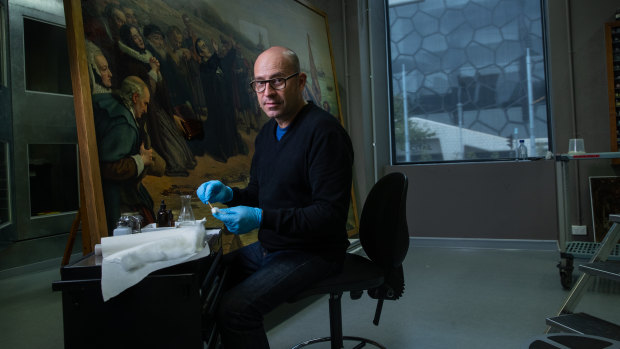This was published 3 years ago
In the cold dark of the shuttered NGV, a conservator worries over dust
By Nick Miller
For a month the National Gallery of Victoria's head of conservation Michael Varcoe-Cocks has been watching mould grow on a cake.
A couple of times a week he makes his way around every room in the closed, dark, chilly museum, torch in hand, the beam picking out wonders. He feels like a time traveller.

NGV's head of conservation Michael Varcoe-Cocks working on the painting The Pilgrim Fathers.Credit: Simon Schluter
"Sometimes I feel selfish," he says, having all this beauty to himself (plus the building's vigilant security team). "I get this great sense of amazement and optimism, seeing these cultural artefacts that stood the test of time."
He stops at Top Arts student Kiara White's Succulent cake 2019, a homemade vanilla cake/sculpture with buttercream icing and lolly snakes.
"We and the artist knew at some point it would get mouldy," Varcoe-Cocks says. "Now we'll have to discard it and they can build another one."
It's an odd part of a serious job. The museum itself is closed (albeit with an impressive level of online activity – last week they beat New York's The Met and Paris' Louvre on one measure of social media engagement). But time marches on. And time is the enemy of art.
"Dust is a problem," says Varcoe-Cocks. It contains organic matter that insects love to nibble on. And removal can be a long, tricky process. "You can't just point the vacuum cleaner at it."
NGV colleagues in isolation at home are "as fast as they can" making dust covers for intricate artworks, fashion and textiles, which Varcoe-Cocks then installs.
In some ways, the shutdown is benefiting the art. They have covered the windows, so sunlight cannot fade it. They have dialled down the temperature as another preservation technique that cannot usually be used (as visitors would complain). And they have set up new data loggers and monitors, to research the effect of temperature and humidity on art.
"This is a unique opportunity," says Varcoe-Cocks.
After his tour logging problems and opportunities, he goes down to the conservation studio where a huge four-square-metre oil painting sits: one of the museum's earliest acquisitions, the 1856 Pilgrim Fathers by CW Cope.
On the last day before they left for home isolation his team took it off the wall, in case there was a chance to work on it. Varcoe-Cocks sits there an hour or so at a time, using hundreds of cotton swabs to remove stubborn dust on the varnish.
"We refer to it as opening up a window in the picture," he says. "This is historic dust, already I'm seeing some of the detail in the brushwork that's really remarkable. It's changing the tone, there is a lot of vibrant colour coming through we haven't seen in many generations."
Once the dust is gone – and hopefully once restrictions have relaxed enough for Varcoe-Cocks' colleagues to help – they will take off the discoloured varnish, which in turn will restore power and presence to the painting. They will replace it with a new varnish, developed by the NGV and the CSIRO, designed to mimic the historical substance with a synthetic chemistry so it's easier to clean next time.
"It will never make it look how the artist painted it, but it will return much closer to the artist's original intention."
Then, finally, the painting will be reunited with its original ornate frame removed in the 1930s. Ready for its audience.
"I walk around, in this state of isolation, and I can't wait for a flood of visitors to come back," says Varcoe-Cocks.